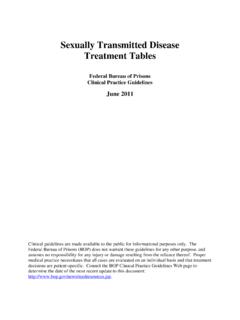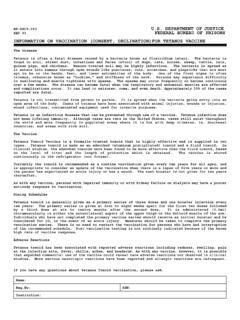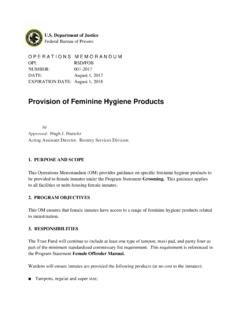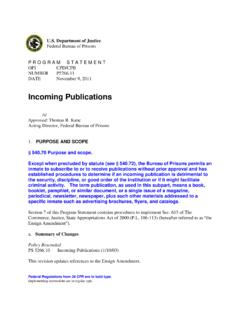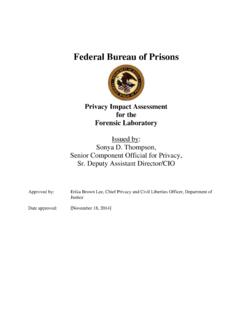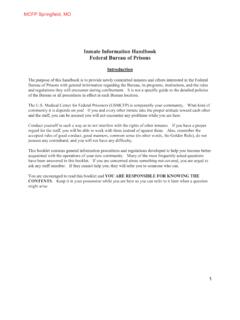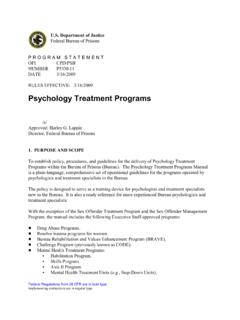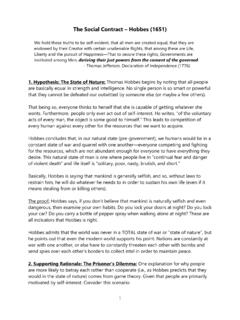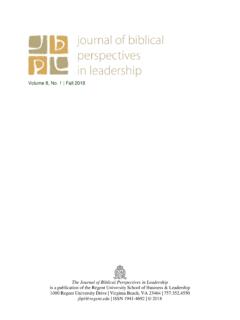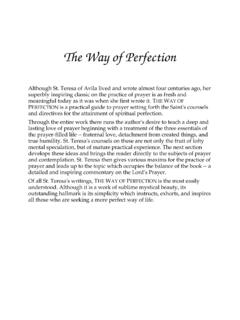Transcription of Orisha Worshippers - Federal Bureau of Prisons
1 Orisha Worshippers Regla de Ocha Candomble Lucumi Oyo Palo Mayumbe Palo Monte Santeria Vodun Yoruba Ifa Religious PracticesReligious ItemsRequirements for MembershipMedical ProhibitionsDietary StandardsBurial RitualsSacred WritingsOrganizational StructureHistoryTheologyResources RELIGIOUS PRACTICES Required Daily Observances. There are no required daily rituals. Personal prayer and sacrifice to one s Orisha is encouraged. Required Weekly Observances. There are no required weekly rituals. However, if it is the practice of the Religious Services Department to accommodate requests for weekly worship and study, it would be appropriate to schedule a weekly community-based meeting of Orisha seekers/devotees and practitioners.
2 Because the rituals reflect the cultures of the regions from which practitioners and seekers have descended, the practices, rituals, and customs vary even from household to household. Community-based celebrations generally center on the worship or study of a particular Orisha to whom household members are dedicated. Fruit is frequently offered to the Orisha . Drum music and dancing are a form of prayer and sometimes bring about an altered state of consciousness a trance state in initiated priests and priestesses. In the trance state, the worshiper becomes spiritually possessed and channels the Orisha , giving the community and individuals information, perform healings, etc.
3 Household rituals are public and open to all who are invited to attend. One s ancestors, egun, are held in high esteem in the Orisha worshipers traditions. Thus, all ceremonies and rituals in the various manifestations of the tradition begin with paying homage to one s ancestors. In correctional facilities, worship or devotion dedicated to one or more particular Orishas are best observed by individuals. Scheduled group services are open to all, for the benefit of all Orisha worshipers, regardless of their particular religious and cultural differences based on their geographic and cultural origin. Seekers of various cultures may wish to participate in Orisha worship services and studies out of curiosity about the unknown, or about spiritist practices.
4 While participation is encouraged, seekers or visitors must honor the traditions and practices of the practitioners and observe or participate respectfully, without imposing contrary practices or beliefs, or disrupting the services. Required Occasional Observances. Rites of membership initiation are only performed by Orisha -worshiping priests and priestesses. These rituals are ordinarily not performed within the institution, except when a priest or priestess from the community is present. Rituals may never include blood or monetary offerings. Monetary or barter fees may not be charged for performance of rituals. Nevertheless, there is great significance attached to the gathering of the household to honor Oludumare, the transcendent, one, great God who rules and sustains the universe.
5 Worshipers also honor the Orishas, the demigods or saintly manifestations of Oludumare, and their deceased ancestors. Orisha -worshiping religions are religions of practice rather than belief. In the wider community these gatherings would generally occur within households or small communities of practitioners and visitors. Divination Rituals and Drumming Ceremonies. These two rituals will be the ones most commonly observed in Prisons . Many individuals practice these divination rituals and are subject to possession trances even though these rituals are usually performed by an Orisha -worshiping priest. Religious Holy Days.
6 Holy day observances are unique for each Orisha , and generally observed by individual seekers or devotees on the feast day honoring the particular Roman Catholic saint whom the Orisha embodies. This list includes the major Orishas honored in the United States, according to scholars and practitioners. Because of the importance of culture and geography in defining the worship, there will never be a comprehensive list of Orishas one should not conclude that other Orishas are not legitimate objects of worship or occasions for celebration. Oggun (January 29): Saint Peter. Oya (February 2): Candelaria/ Saint Teresa. Ochagrinan (March 19): Saint Joseph.
7 Aguema (May 5): Our Lady of Immaculate Conception. Orichaoko (May 15): Saint Isodore. Ochosi (June 16): Saint Norbert. Ellegua (June 13): Saint Anthony of Padua. Aganyu-Sola (July 25): Saint Christopher. Yewa (August 11): Saint Clare. Yemaya (September 7): Our Lady of Regla. Obatala, sometimes named Osshun (September 8-12): Virgin of Mercy, Protector of Cuba (September 24). Los Ibeyi (September 26): Ss. Cosmas and Damian. Orunla (October 4): Saint Francis Assisi. Dada (October 7): Our Lady of the Rosary. Inle (October 24): Archangel Raphael. Chango (December 4): Saint Barbara. Babalu-Aye (December 17): Saint Lazarus.
8 Osain (December 31): Saint Sylvester/Saint Ambrose. The feasts of Obatala, Ellegua, and Chango are common days of celebration. The Orisha -worshiping community may request to have their ceremonial meal on one of these days. According to the legends(patakis)of Orisha worshipers, Obatala is the oldest and wisest of the Orishas. It would be good practice to determine with the Orisha -worshiping community which days the group would prefer to observe for their group ceremonial meal. It would be best to allow them to discuss this and reach a conclusion about the birthday of the Orisha they desire to observe. The date should be set at the beginning of the calendar (or fiscal) year, in accordance with local practice.
9 RELIGIOUS ITEMS The religious items used by Orisha worshipers vary from group to group and devotee to devotee. Most devotees wear a necklace or necklaces (collares, also known as Elekes) representing the colors pleasing to their orishas. Coconut rinds or cowrie shells and a straw mat are used as divination tools. A common divination tool is known as Okuele, a larger size necklace with 6 or 8 rinds of coconut. The best practice with respect to religious items in a correctional setting may be to authorize the number, nature, size, and value of Orisha worshipers religious items, rather than to specifically name them. The Orisha -worshiping community or the devotee may use up to a specified number of congregate items that will be stored in the chapel; each devotee may retain in his/her property a specified number of approved personal religious items.
10 Personal items are ordinarily derived from materials at hand, natural goods used as offerings for the gods; , fruit, grains, seeds, vegetables, flowers, 4 coconut rinds and 21 cowrie shells; scented water (non-alcoholic cologne or after-shave splash), oil or lotion, honey, molasses; a bowl with a lid. A paper image of the Orisha , in the form of a saint, should be authorized. Personal Religious Items. The main personal religious identifier for any Orisha worshiper is the necklace(s) made in the colors of the Orisha under whose protection s/he is initiated. The colors and numbers associated with each Orisha are listed in a separate chart.

